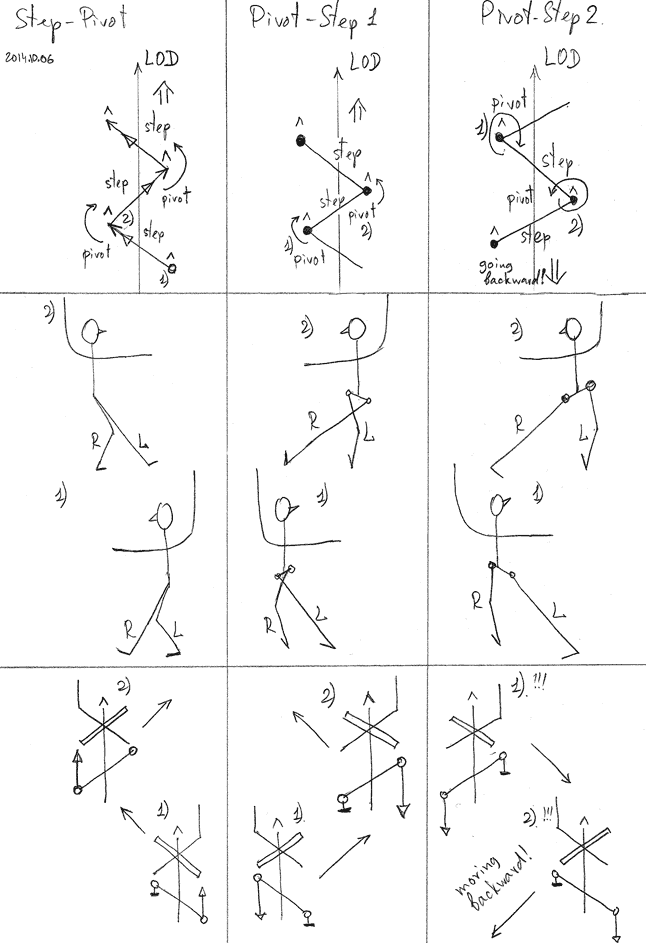
By Igor Polk, October 08, 2014 | Home - check home for more information, blogs and comments
This is a supplement article to a tango book "Twisted Body". Author assumes that you are familiar with the book terminology and abbreviations.
Pivots in Argentine Tango are essential part of the dance. There are pivots forward and backward. Repeatedly done forward pivots and steps are called Forward Ocho or Ocho Adelante.
There are many (about 20) ways to produce a pivot. I am going to consider only three.
It is depicted on the Step-Pivot column of the first diagram below. From Parada position produce a Toe-First Long Step pivoting toward the stepping, front leg. Energy for the pivot comes from the energy of the step when a body is going onto the front leg. After the pivot, a dancer immediately extends the free leg forward coming to the opposite parada pose.
Note that during the pivot the pelvis is being twisted in the opposite direction. It means, that while moving along the line of the dance (LOD) in a zig-zag-like pattern, the pelvis line between the hip-joints is perpendicular (flat) to the LOD, "facing the partner". The same is with upper torso. If arms are extended to the side, they stay exactly in the same plane "facing the partner".
Arm and torso twist greatly helps, but I will not give it too much of importance in this article.
The rhythm is: Step-then-Pivot. Pause after the pivot.
It is depicted on the Pivot-Step 1 column of the first diagram below. Let us prepare the initial position. Stay perpendicular to LOD. Take the Liberty pose. As you know, in this pose the pelvis is twisted "toward the partner", hip-bone of the extended free leg is pushed forward. Now turn your body toward the LOD, "toward the partner". This is done with a pivot toward the partner staying on both legs, feet become directed more toward the partner forming an angle with LOD about 45°. This is an initial position to start this type of forward ocho. Attention ! A hip line between hip-joints must be perpendicular to LOD, or "toward the partner" ! Check it by placing your hands on the hip-bones.
Your pelvis must feel very tight. This is a source of energy for the pivot. Just release this tightness. It will pivot your a little naturally bringing feet together. When feet are "together" the pelvis position is "to the side" ( allowing the side step AROUND the partner, but this is a topic of another article ). Pivot is done. Now step forward in the Body-First way coming to the same pose but on opposite leg, another Liberty pose. Attention, that it is crucial to produce a good Hip-Push during the step.Continuing, this will produce a nice zig-zag progression along the line of dance FORWARD. Arm and torso twist greatly helps, practice it.
The rhythm is Pivot-then-Step. Pause after the step.
It is depicted on the Pivot-Step 2 column of the first diagram below. Take a Liberty pose as described above. Then twist pelvis in an opposite direction stretching the pelvis bone on the free leg side backward as much as possible. The leg will extend back even more and the foot will go away from the face direction. Upper torso and face still must look at the same direction forward. But one can say that now the pelvis is directed "away from the partner".
Now the pelvis is charged in the opposite direction and to a very large degree. Use this stretch to produce a very powerful, juicy pivot which may easy produce a 360° rotation. After the pivot, step using the extension of the free leg hip-joint backward as a driving force.
While facing the LOD, the continuous execution of this Pivot-Steps will create a movement in the backward direction.
The rhythm is Pivot-then-Step. Pause after the step.
The diagram below shows these three ways of Forward Ocho in columns. In the middle it shows the body illustration, at the bottom - a diagram of the body poses, and at the top, the step diagram. Note the "nose" direction. Quick reminder, arrows represent Toe-First steps, a line with a dark dot at the end - Body-First steps. A little "bird" specifies a "nose direction", where a dancer looks. Toward the partner mostly, of course. If partners are looking to the side as it supposed to be in tango, the bird represents the direction of Upper Torso. Pivots are shown with the round arrows.

All three methods are very distinct technically.
When I am asked how to lead ochos, forward and backward, the best advice I can give is to do it together synchronously. In case of Forward Ochos, it means she is stepping forward and a man is stepping in the same direction, she is pivoting, and he does, in the same direction.
There are two ways to do ochos together: with pivots from Parada to Parada and from Liberty to Liberty. There is no any arbitrary other way: one of these two when each one is done with the right rhythm: the pause at the end is very important. When doing it with the syncopa rhythm, do the first phase in the first syncopa and the second phase with the second syncopa making sure you pause on 4. It is a normal, slow way. In a fast way, one step-one pivot is done on one syncopa making it 2 pivots per measure. But that is too fast for a regular dancing.
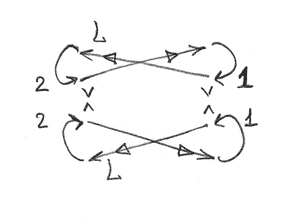 Parada to Parada Forward Ocho done in the Same DirectionIt starts from a promenade position of partners while both are in Parada. This is a difficult figure to start, especially for men who are usually larger and less flexible, but this figure teaches how to lead forward pivot very well. Leading pivot backward is the same only opposite. Note again, arms, upper torso, and pelvis line do not deviate from the plane 1-2 between dancers. To achieve that, the body must twist like a hell ! And this is the essence of tango. |
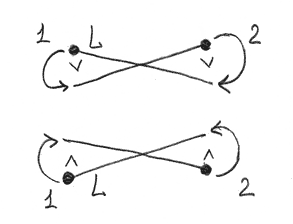 Liberty to Liberty Forward Ocho done in the Same DirectionThe same applies to this figure. It starts from a promenade position of partners while both are in Liberty. 1. is a starting position and the first pivot. 2. is the second position after the step. I have found that the most difficult part for an average dancer here is to perform Hip-Push, propelling that hip forward while stepping. To train it, run uphill. |
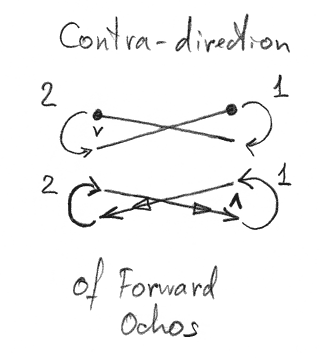 Forward Ochos done in Contra-DirectionsPartners are doing ochos moving contrary to each other. This is an even more difficult figure to start with, but it is indispensable in learning the right body technique. I would say, this is the figure of choice of old master's training. This figure will teach how to move and how to lead better than anything else. Usually, a man does Step-Pivot from Parada, and a woman - Pivot-Step 1 from Liberty, since this is perfect for making sacada. On the figure, 1 is the starting position, 2 is a second position: after a pivot for a man, after a step for a woman. Do not forget about a pause! A woman should be very aware of her partner and her movements in relation to the partner. This trains the main principle of following: following is an active process, not passive. A follower is dancing what a leader leads and she stays with him. It is possible to do this in a way when a man goes from Liberty and a woman from Parada. Man still leads, but in this case, a woman can step to his foot producing a sacada. While making sacadas, a pause makes a special importance. A dancer who is in Liberty, stretches her leg more, deliberately as if she is inviting the partner to step to her foot. (This is goes for "him" as well.) Producing Pivot-Step 1 in such way when the pelvis is twisted toward the partner makes a tight, compact figure. Theoretically, this figure is can be done in close embrace and, of course, on a most crowded floor, since essentially partners exchange the place with each other. |
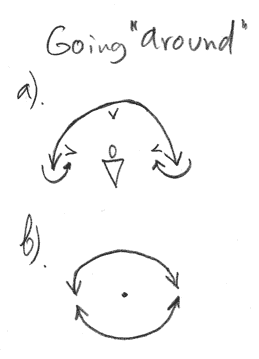
Even a foot travels around a partner making a curve. This can be exercised when one partner stands in a center just moving upper torso left and right while another partner goes around, but it should eventually come to both partners making the ochos, both producing half-circles. This is possible only when a dancer is producing Liberty Ochos as Pivot-Step 1. |
|
|
A man does not have to make Forward Ocho while leading his partner to dance it. He leads it, his upper body works as if he is making Forward Ochos himself, but he can stay on his feet and he can make any other crazy movements with his legs: changing feet, accompanying her legs with his free foot, and so on. Doing ochos together with a woman will teach a man how to lead with torso. A test for the ability to lead pivots and ochos correctly is to stand on one leg only and lead her an ocho with his torso right in front of him.
Besides that, the best, most useful position is when she is on his right and he leads her Forward Ochos with his pelvis staying directed toward her twisted right. His Right leg is forward crossing in front of her, this allows a good twist in the pelvis. He accompanies her steps with movement of his center form back to front leg.
His side position is often used for practicing, but I do not advise it.
Likewise he can lead her to Forward Ochos on his left while the left leg is in front. This is very difficult because of embrace.
A man can lead a woman with his pelvis, not torso. Investigate it yourself.
Ochos can have many variations. All sorts of boleos add variety.
The whole theory described here is suitable for Back Ocho. All the same, only opposite.
Any pivot is lead in a similar way. Consider it a part of an ocho.
A boleo is lead in a similar fashion, only you do not make a step, but alternate lead to Forward Pivot and to Back Pivot.
More about it later.
* * *
Copyright(C)2014 Igor Polk